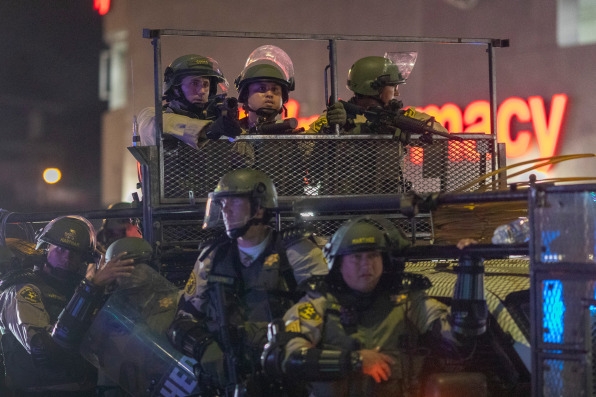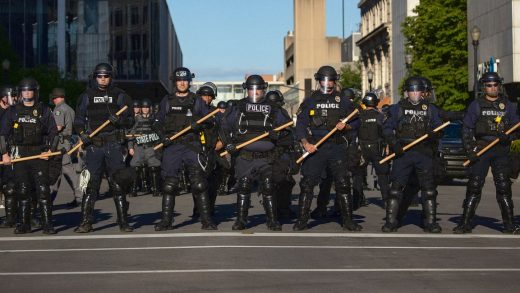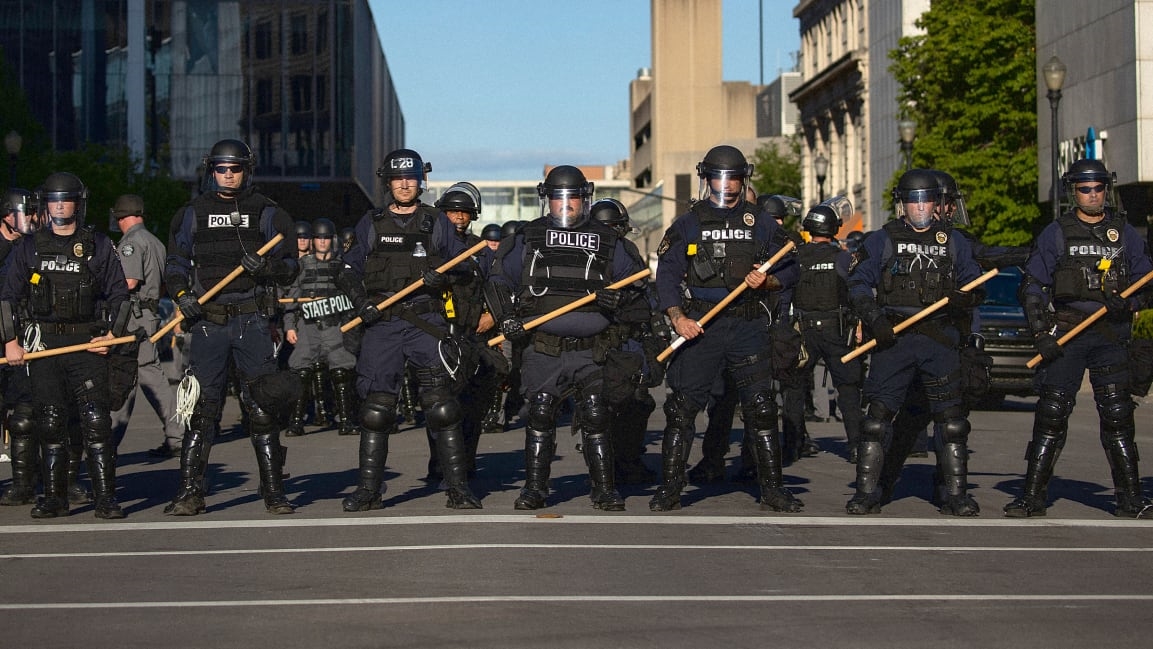As cities make deep cuts because of COVID-19, police departments are keeping their funding
As images from protests against police brutality in the wake of George Floyd’s death have spread around the country, a key demand from protesters has been the defunding of city police departments: that cutting the money a city spends on police would, in fact, make communities safer. They’ve pointed to the tactical gear and equipment that the police have been pictured using as evidence that cities spend far too much money on their law enforcement, at the expense of other agencies that often lack funds to offer basic services to residents.
This is an apt time to be making that demand, as cities are in the process of figuring out next year’s budgets. But despite the fact that every U.S city is being forced to make drastic cuts to existing programs in the face of a stunning loss of tax revenue from closed businesses during the COVID-19 pandemic, one area of city government is seeing virtually no cuts at all: police departments.
Under New York mayor Bill de Blasio’s budget proposal for fiscal year 2021, the NYPD—which currently has a budget of $6 billion—would see a cut of just $23.8 million, or 0.39%, Gothamist reported. In contrast, the Department of Education would have its budget cut by $827 million—3% of its overall funding. The Department of Youth and Community Development, which funds after-school programs, literacy services, and summer youth work programs, would lose 32% of its budget.
In a letter to the mayor sent May 30, New York City Council Speaker Cory Johnson and other council members called for every city agency to identify meaningful savings they could make, so the nearly $9 billion budget gap is made up with 5-7% cuts from each department, rather than disproportionately larger cuts for a few agencies. “No proposed cut should be one that would weaken the social safety net or hurt vulnerable New Yorkers,” they wrote. An April letter sent to de Blasio from the Communities United for Police Reform pointed out that in 2019, when the city allocated $6 billion to the NYPD, it allocated just $2.1 billion to homeless services, $1.4 billion to housing, preservation, and development, and $1.9 billion to the health department.
In Los Angeles, the LAPD budget is slated to actually increase by $123 million. The proposed 2020-2021 spending includes nearly $41 million in bonuses for officers who have college degrees, “even as thousands of other city employees face pay cuts amid a financial crisis at City Hall,” the Los Angeles Times reports, along with pay raises for officers. Overall, the current plan increases LAPD’s budget by 7.1%, while it cuts the budget for the Housing and Community Investment Department, which, per the Times, “sends inspectors to look for violations at apartment buildings,” by 9.4%.
LAPD will receive just under 54% of Los Angeles’s total general fund—money not raised or collected for special purposes such as voter-passed measures—which allocates $1.8 billion to the agency. When you include pensions and retirement, building services, liability claims, and “other department related costs,” though, the total price tag of the police department tops $3 billion.

[Photo: David McNew/Getty Images]
In 2017, Oakland allocated the highest share of its general fund to policing, according to a Center for Popular Democracy study on police budgets, with $242.5 million going to police, or 41% of city expenditures. Oakland is facing a predicted $80 million budget gap over the next 14 months. Since Oakland passes two-year budgets, the city isn’t currently in the budget proposal process, but in a memo to the City Council, Adam Benson, the city’s budget director, quantified this shortfall in an interesting way: “If the full annual cost for a police officer is approximately $250,000 annually, then $80 million is equal to the cost of funding 320 police officers for one year—about half of the City’s police force,” Benson wrote.
When Minneapolis passed its 2020 budget in December 2019, it included increased police funding for as many as 30 new officers. In that budget, police expenditures total $193 million. That’s about 60% more than the $119 million the city’s Community Planning and Economic Development Department, which handles affordable housing and employment opportunities for low-income residents and teens, received.
When people protesting police brutality urge the defunding of police, this is what they are addressing. “Instead of further investing in the police, we need to invest not only in community-based programs for public safety, but we also need to invest in people’s ability to have access to food, clothes, shelter, health care, education, and gainful employment—the necessities of life. This is why we have these issues in our communities,” Sean Blackmon, an organizer with Stop Police Terror Project DC, a group that advocates for the end of militarized policing and alternatives to policing that would build community, said in a video he posted to Twitter Monday morning.
Washington, D.C.’s proposed 2021 budget adds $1.7 million to the Metropolitan Police Department’s budget, even as it aims to cut $166 million from other agency budgets. D.C.’s fiscal year 2020 general fund allocated $522 million to MPD. “The DC police don’t need any more money,” Blackmon continued in his video. “We need to divest from the police and invest in DC’s black communities and in DC’s poor, working, and oppressed communities.”
Spending more on policing does not necessarily make a community safer. Though nationally crime has dropped across those same three decades that police spending increased, the Center for Popular Democracy says that drop is in spite of increased spending, not because of it.
“Study after study shows that a living wage, access to holistic health services and treatment, educational opportunity, and stable housing are far more successful in reducing crime than police or prisons,” the center, which works to transform state and local policies through partnerships with community-based organizing groups, wrote in its 2017 report. In Minnesota, even as crime rates declined since the 1990s, the state’s prison population grew, reaching one of its highest levels in 2013.
Defunding the police would also reduce city-related expenses around legal fees for police misconduct, freeing up millions that cities can use to invest in their communities. From 2006 to 2012, Minneapolis paid nearly $14 million in lawsuits “related to excessive force leading to death or injury, cases involving property damage during raids, and the use of racial slurs.” In New York City, between June 2017 and June 2018 alone, taxpayers spent $230 million to settle 6,472 lawsuits against the NYPD. As millions of Americans struggle with rent, schools continually face strapped budgets, people drown in medical bills, and, most recently, hospitals have had to rely on PPE donations and are also facing financial ruin during a pandemic, activists are asking cities to consider if they’re really allocating their budget most effectively.
Even if former Minneapolis Police officer Derek Chauvin is convicted in the death of George Floyd, that won’t fully deliver justice to black communities, Jennifer Epps-Addison, network president and co-executive director of Center for Popular Democracy, said in a statement on Friday. “The only way for us to win real liberation,” she said, “is to transform our systems by divesting from policing, investing in community-led solutions, and demanding that politicians take concrete legislative action at every level from the City Council to Congress.”
(8)



